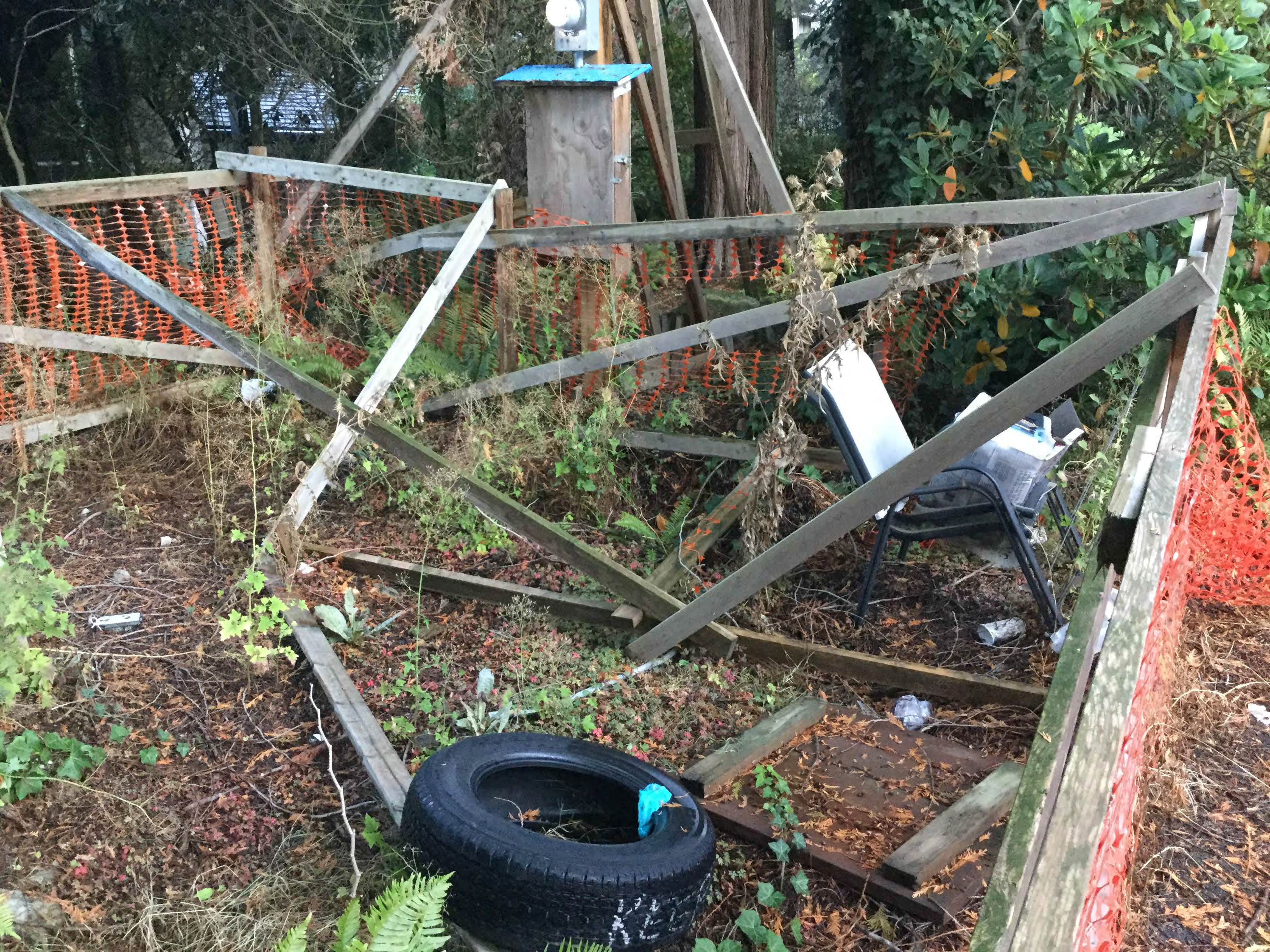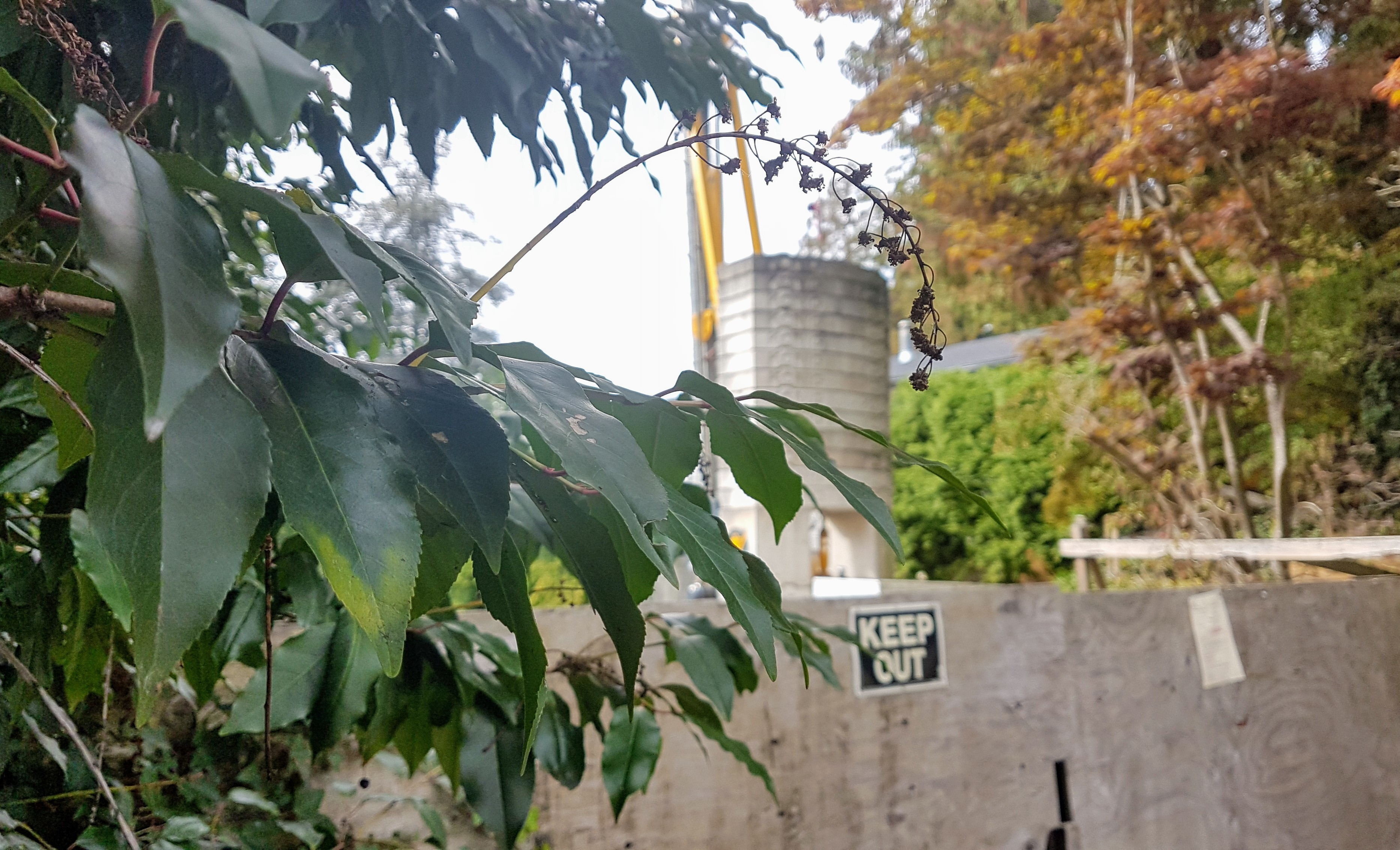September 17, 2018
There's a hole in the ground as big as a mansion at 6289 Carnarvon St.
It's been there for three years now, watched over by one idle construction crane and a growing crowd of weeds.
The pit used to form the foundation of a unique home designed by the influential West Coast modernist Daniel Evan White, and the owner says she’d planned to fix it up and move in with her daughter.
And yet somehow, it was torn down.
Exactly why that was allowed to happen remains a mystery — and is the subject of much bewildered gossip in Vancouver’s architecture community.
That’s because the 10,000-square-foot home appears to have been demolished on the instructions of the owner’s estranged husband, without her signed approval.
It's possible this significant piece of Vancouver’s built history has been lost to spite.

Newly obtained documents show that a demolition permit for the property was issued in the name of Sheng Yun Dong, the former husband of the mansion’s sole owner, Jin Fang Li.
And Li’s signature is missing on a mandatory piece of paperwork submitted with the application for that permit, according to the records, released through a Freedom of Information request to the city.
Li claims Dong arranged to have it torn down while she was out of the country, and she filed suit against him and the city two years ago.
No matter how and why it happened, the destruction of the home is a major loss to the city’s architectural heritage, according to UBC professor Martin Lewis.
“It’s clearly valuable and irreplaceable. It’s one of a kind,” Lewis told CBC. “That somebody would not have known that this was a significant property, and done due diligence about the owner, strikes me as being interesting.”

But the full story of what happened to the mansion is tough to pin down.
Li accuses city staff of negligence for failing to properly review the owner's undertaking to make sure it was signed. In her lawsuit, she says the city owed her a duty of care to make sure everything was done by the books.
"The city failed to carry out that duty of care by issuing a demolition permit in connection with the property ... without the knowledge or consent of Ms. Li," the claim alleges.
Li did not respond to requests for comment made through her lawyer, James Henshall, and Henshall declined to answer any questions.
The whereabouts of her ex, Dong, are unknown. The phone number listed in the FOI documents now belongs to someone else, and everyone involved in the project says they haven’t heard from him in years.
Meanwhile, a Vancouver spokesperson has declined to comment on what happened, saying it would be inappropriate while Li’s legal claim against the city is still open.

Still, there are a few indisputable facts.
Land title records show that Li has owned 6289 Carnarvon St. since 2012.
She received a permit to renovate the house the next year, with planned updates to both the interior and exterior, the FOI documents show.
But in June 2014, another application was submitted to tear down the house completely. That application included an owner’s undertaking, which is required by the city for any demolition project.
Though Li is identified as the owner in that document, the space for her signature has been left blank.
Nonetheless, the demolition permit was approved on Feb. 25, 2015, with Dong, also known as Sheng Yun Don, listed as the owner. The couple filed for divorce a few days later, court records show.

Those familiar with the City of Vancouver’s permit application process told CBC the owner’s undertaking is an essential piece of paperwork.
It’s a “critical” document that has to be signed before the city will approve a demolition permit, according to Larry Clay, chair of the Greater Vancouver Home Builders Association.
“It must be done,” Clay said. “Here’s the problem: If you don’t have an owner’s undertaking, you could have the wrong home being demolished, or the owner not aware that his home is being demolished.”
In other words, the system was developed to prevent the exact situation that Li has alleged.
A builder acting on behalf of a homeowner has to do a title search confirming ownership of the property before applying for permits, according to Clay. But he said that if a contractor submits a permit application to the city without a signed undertaking, it should be rejected.

Li filed her lawsuit against Dong and the city in August 2016, also naming an architect and some of the contractors involved in the project as respondents.
In her statement of claim, she says she planned to live in the home with her daughter once the renovations were complete.
“In or about summer 2015 while Ms. Li was in China, the defendants … without the knowledge or consent of Ms. Li and operating under the permits issued by the city, demolished the residence,” the claim alleges.
Though Dong commissioned an architect to design a new house for the site, Li alleges her ex never intended to pay for its construction.
“Rather, he intended as he did to stop paying after demolition of the residence was completed and thereby to bring construction of the new house to a halt and to paralyze the property and thereby compel Ms. Li to sell the property,” the claim says.
Li put the property on the market after the demolition, asking $7.8 million, but it did not find a buyer. It is currently valued at more than $7.6 million, according to B.C. Assessment.

No one named in Li’s suit has filed a statement of response, and none of the allegations have been proven in court.
The respondents include contractor Zichun Zhao and his son Scott’s company Pro Design Co. Ltd. Scott Zhao told CBC that both he and his father only signed on to the project after the demolition permit was issued.
Zhao said he and his father haven’t seen or heard from Dong since the lawsuit was filed, and neither has been served with the statement of claim.
Demolition contractor Paul Hayer of Richmond’s Hayer Demolition did not return multiple calls requesting comment.

The only person involved who agreed to speak on the record is architect Robert Billard. He says he doesn’t know why Dong was granted a demolition permit, but he was gutted that this important piece of modern history was torn down.
According to Billard, the paperwork for the demolition permit was handled by Yong Feng Enterprises, the original contractor on the project. The FOI documents show that Yong Feng director Bob Wang signed the owner’s undertaking as a witness.
“Typically, if there is an anomaly in the paperwork the application is not ‘taken in’ by the city or we are notified by the City of Vancouver to have it rectified,” Billard wrote in an email to CBC.
A woman who answered the phone at Yong Feng this week declined to answer questions about the project or transfer the call to Wang. She said the company was only involved in the initial design for the new home, and was later replaced.

The destruction of the house and its connection to local design history was a loss that Billard felt keenly.
Though the house at 6289 Carnarvon was only completed in 1992 and did not have a heritage designation, it was an architecturally significant structure designed by a key figure in modern West Coast style.
Daniel Evan White trained under Arthur Erickson, and while he may not be a household name, his work was important enough to be the subject of an exhibition at the Museum of Vancouver four years ago.
Between the 1970s and 1990s, he built some of the region’s most expensive single-family homes. Some of those properties are now worth more than $13 million, according to B.C. Assessment.
Map: B.C. homes designed by Daniel Evan White

Billard said it was “upsetting” to watch the home be demolished.
“I didn’t want to have to tear it down, either. There was an initial discussion on if they could renovate it and I was told that the cost to renovate was higher than tearing it down,” Billard wrote in an email to CBC.
He said that by the time he signed on to the project, the interior of the home was already partially dismantled, and there was extensive water damage to the lower floor.
Billard added that a woman was on hand for a couple of his meetings with Dong and the contractor, but neither spoke English.
“I, of course, did not ask what the relationship was, but assumed it was his wife,” Billard said.

Today, Billard is still holding out hope that he’ll be asked to complete his plans for the new house.
While he waits, the abandoned construction site has been the subject of two legal notices from the city in 2018, warning that conditions at the property are potentially unsafe. After a rainy day, puddles as deep as 60 centimetres form inside the pit, threatening the erosion of neighbouring properties, according to the most recent notice, posted on Sept. 10.
The city has ordered the owners to remove the crane and fill in the hole by Sept. 24, or face prosecution.

Lewis, who was an associate of White’s, said the loss of 6289 Carnarvon proves Vancouver needs to do more to protect its modern heritage.
“Something built today could just as easily be … of significance and understood as such,” Lewis said.
“I would think the city has to reassess what it sees as valuable architectural, cultural, physical artifacts in terms of saving.”
